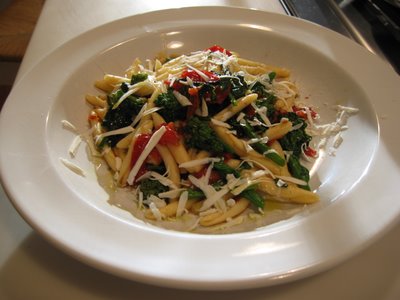Pasta Primavera with Asparagus and Poached Egg, Locavore Style
 photo by Josh Monken for Sauce
photo by Josh Monken for SauceAnd I'll find just about any excuse to eat fresh pasta, especially when the entire dish features ingredients that I've sourced locavore-style. I have a thing for oozy poached eggs, and using them as a topper for pastas and salads provides little extra protein and brilliant orange color.
I wrote a feature about this recipe which appears in the May, 2008 issue Sauce Magazine, which I had posted recently but have removed for copyright reasons - instead, you can read the full story on the Sauce website.
 photo by Josh Monken for Sauce
photo by Josh Monken for Sauce4 ounces fresh goat cheese, softened at room temperature
2 tablespoons heavy cream
¼ cup grated Parmigiano-Reggiano cheese
Finely grated zest and juice from half a lemon
Fine sea salt and freshly ground black pepper
1 bunch asparagus, stems trimmed and sliced into 2-inch pieces
9 ounces fresh fettuccine or tagliatelle pasta
4 soft-poached quail eggs*
1. Arrange the prosciutto on a small baking sheet and roast in a 400-degree oven for about 10 minutes, or until crisp. Cool slightly and break into pieces. (prepare up to one day ahead - keep in a covered container at room temperature)
2. Crumble the goat cheese into a large mixing bowl. Add the cream, Parmigiano-Reggiano, lemon zest, juice, salt and pepper to taste and stir until smooth.
3. Bring 5 quarts water to a boil in a large saucepan and add 1 tablespoon salt. Drop in asparagus and cook until bright green and tender, about 3 minutes. Remove asparagus with a slotted spoon and add to the goat cheese mixture. Add pasta to the pan and cook 1 - 2 minutes, or according to directions. Scoop out a ladleful of pasta water (about 1/3 cup) and pour it into the goat cheese mixture, stirring to melt cheese and make a smooth sauce. Drain pasta and toss with the goat cheese until evenly coated with sauce.
4. Divide pasta between two serving bowls. Top with poached eggs and sprinkle with prosciutto.
Serves 2
* To poach eggs, bring a small skillet full of water to a simmer. Add a tablespoon of plain white vinegar. Crack eggs into the pan; keeping heat at a steady simmer (not boiling), cook eggs until whites are firm and yolks are just set, about 2 minutes for quail eggs and 4 minutes for chicken eggs. Remove with a slotted spoon.
 Save This Page on Del.icio.us
Save This Page on Del.icio.us



























